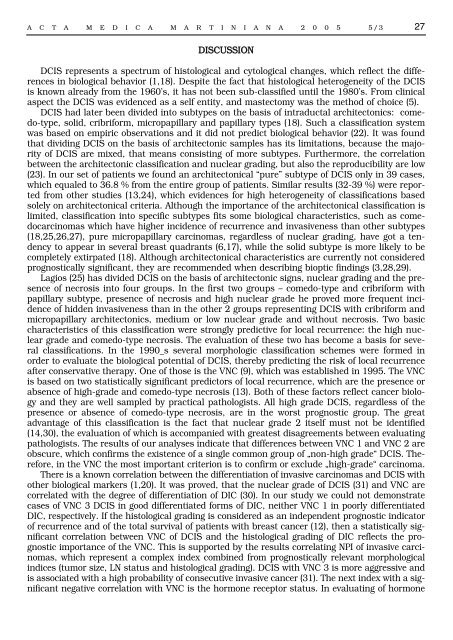MAKETA 5/3
MAKETA 5/3
MAKETA 5/3
You also want an ePaper? Increase the reach of your titles
YUMPU automatically turns print PDFs into web optimized ePapers that Google loves.
A C T A M E D I C A M A R T I N I A N A 2 0 0 5 5/3 27<br />
DISCUSSION<br />
DCIS represents a spectrum of histological and cytological changes, which reflect the differences<br />
in biological behavior (1,18). Despite the fact that histological heterogeneity of the DCIS<br />
is known already from the 1960’s, it has not been sub-classified until the 1980’s. From clinical<br />
aspect the DCIS was evidenced as a self entity, and mastectomy was the method of choice (5).<br />
DCIS had later been divided into subtypes on the basis of intraductal architectonics: comedo-type,<br />
solid, cribriform, micropapillary and papillary types (18). Such a classification system<br />
was based on empiric observations and it did not predict biological behavior (22). It was found<br />
that dividing DCIS on the basis of architectonic samples has its limitations, because the majority<br />
of DCIS are mixed, that means consisting of more subtypes. Furthermore, the correlation<br />
between the architectonic classification and nuclear grading, but also the reproducibility are low<br />
(23). In our set of patients we found an architectonical “pure” subtype of DCIS only in 39 cases,<br />
which equaled to 36.8 % from the entire group of patients. Similar results (32-39 %) were reported<br />
from other studies (13,24), which evidences for high heterogeneity of classifications based<br />
solely on architectonical criteria. Although the importance of the architectonical classification is<br />
limited, classification into specific subtypes fits some biological characteristics, such as comedocarcinomas<br />
which have higher incidence of recurrence and invasiveness than other subtypes<br />
(18,25,26,27), pure micropapillary carcinomas, regardless of nuclear grading, have got a tendency<br />
to appear in several breast quadrants (6,17), while the solid subtype is more likely to be<br />
completely extirpated (18). Although architectonical characteristics are currently not considered<br />
prognostically significant, they are recommended when describing bioptic findings (3,28,29).<br />
Lagios (25) has divided DCIS on the basis of architectonic signs, nuclear grading and the presence<br />
of necrosis into four groups. In the first two groups – comedo-type and cribriform with<br />
papillary subtype, presence of necrosis and high nuclear grade he proved more frequent incidence<br />
of hidden invasiveness than in the other 2 groups representing DCIS with cribriform and<br />
micropapillary architectonics, medium or low nuclear grade and without necrosis. Two basic<br />
characteristics of this classification were strongly predictive for local recurrence: the high nuclear<br />
grade and comedo-type necrosis. The evaluation of these two has become a basis for several<br />
classifications. In the 1990_s several morphologic classification schemes were formed in<br />
order to evaluate the biological potential of DCIS, thereby predicting the risk of local recurrence<br />
after conservative therapy. One of those is the VNC (9), which was established in 1995. The VNC<br />
is based on two statistically significant predictors of local recurrence, which are the presence or<br />
absence of high-grade and comedo-type necrosis (13). Both of these factors reflect cancer biology<br />
and they are well sampled by practical pathologists. All high grade DCIS, regardless of the<br />
presence or absence of comedo-type necrosis, are in the worst prognostic group. The great<br />
advantage of this classification is the fact that nuclear grade 2 itself must not be identified<br />
(14,30), the evaluation of which is accompanied with greatest disagreements between evaluating<br />
pathologists. The results of our analyses indicate that differences between VNC 1 and VNC 2 are<br />
obscure, which confirms the existence of a single common group of „non-high grade“ DCIS. Therefore,<br />
in the VNC the most important criterion is to confirm or exclude „high-grade“ carcinoma.<br />
There is a known correlation between the differentiation of invasive carcinomas and DCIS with<br />
other biological markers (1,20). It was proved, that the nuclear grade of DCIS (31) and VNC are<br />
correlated with the degree of differentiation of DIC (30). In our study we could not demonstrate<br />
cases of VNC 3 DCIS in good differentiated forms of DIC, neither VNC 1 in poorly differentiated<br />
DIC, respectively. If the histological grading is considered as an independent prognostic indicator<br />
of recurrence and of the total survival of patients with breast cancer (12), then a statistically significant<br />
correlation between VNC of DCIS and the histological grading of DIC reflects the prognostic<br />
importance of the VNC. This is supported by the results correlating NPI of invasive carcinomas,<br />
which represent a complex index combined from prognostically relevant morphological<br />
indices (tumor size, LN status and histological grading). DCIS with VNC 3 is more aggressive and<br />
is associated with a high probability of consecutive invasive cancer (31). The next index with a significant<br />
negative correlation with VNC is the hormone receptor status. In evaluating of hormone
















